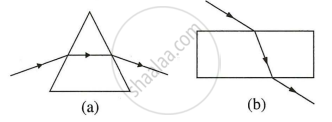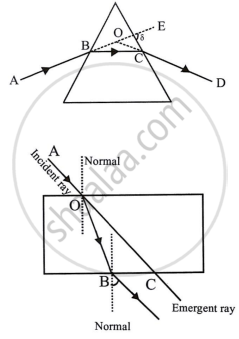Advertisements
Advertisements
प्रश्न
Diagrams (a) and (b) in figure below show the refraction of a ray of light of single colour through a prism and a parallel sided glass slab respectively.

- In each diagram, label the incident, refracted, emergent rays and the angle of deviation.
- In what way the direction of emergent ray in the two cases differ with respect to the incident ray? Explain your answer.
उत्तर
-
-
AB stands for the incident ray. BC stands for a refracted ray. CD stands for emergent radiation. The angle of deviation is ∠EOD, where the incident ray produced forward meets the emerging ray produced backward.
-
AO stands for incident radiation. OB stands for a refracted ray. BC stands for the emerging ray. There is no angle of deviation, since the incident ray in a glass block is parallel to the emergent ray.

-
-
In the glass prism, the incident beam AB would have gone along ABEF in the absence of the prism. It seems that the emergent ray CD is progressing ECD. Thus, the ray AB has been deviated through ∠FED = δ along CD.
In the slab of glass, emergent ray CD emerges in a rare medium, deviates from the normal, and is parallel to incident ray AB.
APPEARS IN
संबंधित प्रश्न
A light ray of yellow colour is incident on an equilateral glass prism at an angel of incidence equal to 48° and suffers minimum deviation by an angle of 36°.
- What will be the angle of emergence?
- If the angle of incidence is changes to (a) 30°, (b) 60°, state whether the angle of deviation will be equal to, less than or more than 36°?
A ray of light is normally incident on one face of an equilateral glass prism. Answer the following:
What is the angle of refraction from the first face of the prism?
A ray of light is normally incident on one face of an equilateral glass prism. Answer the following:
What will be the angle of incidence at the second face of the prism?
A ray of light incident at an angle of incidence 48° on a prism of refracting angle 60° suffers minimum deviation. Calculate the angle of minimum deviation.
[Hint: δmin = 2i - A]
In an experiment to trace the path of a ray of light through a glass prism for different values of angle of incidence a student would find that the emergent ray:
How will you use two identical prisms so that a narrow beam of white light incident on one prism emerges out of the second prism as white light? Draw the diagram.
The angle between two plane rectangular refracting surfaces of a prism is called as
White light is dispersed by a prism. Inside the prism, compared to the blue light, the red light ______.
State three factors on which the angle of deviation depends.
